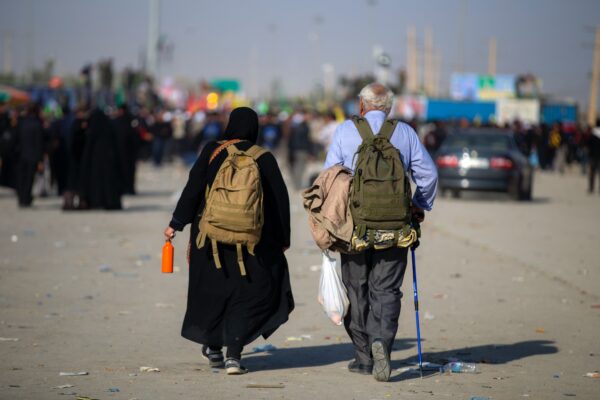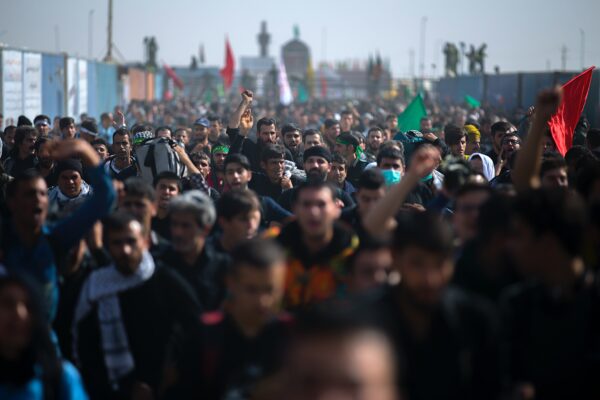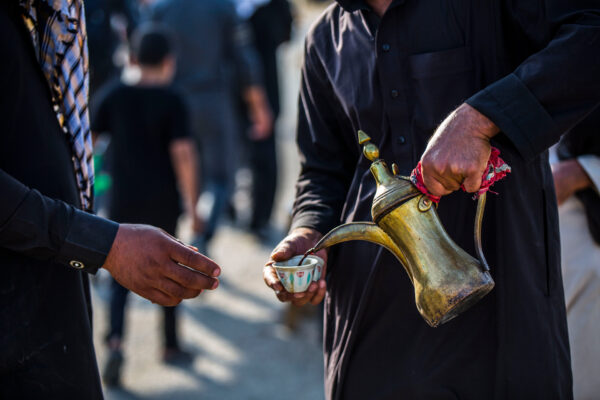Many Muslims have begun the journey to the shrine of Imam Hussain, known as the Arbaeen Walk. Here’s everything you need to know about its significance and history.
Many Muslims have begun the journey to the shrine of Imam Hussain, known as the Arbaeen Walk. Here’s everything you need to know about its significance and history.
Every year, millions of Muslims walk to the city of Karbala, Iraq, the final resting place of Hussain ibn Ali, the grandson of the Holy Prophet (PBUH). Their aim is to reach Imam Hussain’s grave by no later than the day of Arbaeen.
What makes people shut down their businesses and leave their houses to perform a walk, which takes days and even weeks to complete? In this article, I look into the history behind the Arbaeen walk. A walk that has been described as “the journey of love”, “the walk of the free” and “the journey of passion.”
What is the Day of Arbaeen?
Arbaeen translates to 40 or 40th. In this context, it marks the 40th day since the martyrdom of Imam Hussain at the Battle of Karbala. Technically, every deceased Muslim has their own day of Arbaeen. In many Muslim communities, the family and friends will gather on the 40th day after their loved one’s death to recite Quran, dua, and dhikr on their behalf with the hope the reward will go to the deceased. Unless the deceased has left behind sadaqah jariyah there is no way for them to perform good deeds, which is why loved ones will often perform deeds on their behalf in the hope it will make the time they spend in the grave comfortable.
Imam Hussain’s day of Arbaeen is on the 20th of Safar and is marked by millions of Muslims, predominantly Shia but also those belonging to other Islamic sects and religions.
But why is the 40th day after his or any other Muslim’s death so important? It is largely because the number 40 is significant in Quranic and hadith literature, leading many to center certain rituals and practices around 40 days. Here’s a selection of the number ’40’ appearing in the Quran and hadith.
Allah (SWT) Loves the Number 40
For reasons that are relatively unknown to even the most learned scholars, traditions and practices are linked to the number 40. Here are some examples from the Holy Quran:
Musa (AS) Spends 40 Days and Nights at Mount Sinai
Allah (SWT) originally intended for Prophet Musa to remain at Mount Sinai for 30 nights and later extended it to 40 nights. While he was at Mount Sinai, he fasted and performed other acts of worship and was gifted the taurat (old testament). Allah (SWT) says in the Quran:
And We Made an appointment with Moses for thirty nights, and completed them with ten more; thus, the trust of his Lord was completed in forty nights.”
[7:142]
People Reach Their Prime Age at 40
According to the Quran, the prime age for any individual is 40:
We have commanded people to honour their parents. Their mothers bore them in hardship and delivered them in hardship. Their ˹period of˺ bearing and weaning is thirty months. In time, when the child reaches their prime at the age of forty, they pray, “My Lord! Inspire me to ˹always˺ be thankful for Your favours which You blessed me and my parents with, and to do good deeds that please You. And instil righteousness in my offspring. I truly repent to You, and I truly submit ˹to Your Will˺.”
[46:15]
The verse seems to suggest that a person hits their peak in terms of maturity and wisdom at 40, which inspires them to recite a dua for their parents and (maybe) become more religious after that age.
Our Prophet Muhammad (PBUH) was 40 when Allah (SWT) felt he was ready to start receiving revelation. This adds further weighting to people hitting their ‘best years’ at 40.
Punishments Last 40 Years
Going back to the story of Musa. After he completed his 40 days, he returned and found his people returning to polytheism and other deviant practices. On behalf of himself and his brother, Harun, Musa asks Allah (SWT) to be exempt from punishment as they have nothing to do with such rebellious practices. Allah (SWT) responds:
Then this land is forbidden to them for forty years, during which they will wander through the land. So do not grieve for the rebellious people.”
The Significance of the Number 40 in Hadith
Very briefly, here is a summary of the significance of the number 40 found in hadith literature. By no means is this an extensive list:
- Prophet Muhammad says anyone who memorises 40 of his hadith will be resurrected as a scholar on the Day of Judgement [Al-Kafi].
- The Prophet also said that if a person reaches 40 years of his/her life and still hasn’t repented Satan will consider his work complete. Once again, with the age of 40 being the peak age, this hadith indicates it would be the prime time to make changes. This is mentioned in Wasail al-Shia.
When Did The Arbaeen Walk Start?
Jabir ibn Abdullah al-Ansari was the first individual to travel to the grave of Imam Hussain. Jabir lived to very old age. He was alive from the time of the birth of Islam and the first revelation of the Quran all the way to the conquest of Mecca and lived for decades after the death of the Prophet. He had seen it all and had an immense amount of love for the Prophet. When he found out that the Prophet’s grandchild was martyred, he went to visit his grave. In actuality, it was not a grave at this time. Some traditions say Imam Hussain was left unburied for three days. Jabir arrived at the same time as Imam Hussain’s son, Ali ibn Hussain. Ali ibn Hussain was returning from Syria, where he was imprisoned in the aftermath of Karbala. Ali ibn Hussain buried his father and the other martyrs.
The Development and Crystallisation of the Arbaeen Walk
The tradition of visiting the grave of Imam Hussain (as) crystallised in the subsequent years. This was due to two reasons.
Firstly, the word spread about the events of Karbala. People were shocked by the way Imam Hussain was killed. The crimes of Yazid and the Ummayad empire were exposed. More and more people wanted to visit the grave to pay their respects.
Secondly, the progeny of Imam Hussain kept the tradition alive. They would frequently encourage people to visit the grave of Imam Hussain. Subsequently, the tradition has been passed down to the present day. Over many centuries the shrine of Imam Hussain has been expanded and renovated to accommodate the growing number of visitors. The visits increase at the start of Muharram and hit their peak on the day of Arbaeen as many set the objective to visit the shrine by then.
Objections to the Arbaeen Walk
Many Muslim empires such as the Ummayads, Abbasids, and even contemporary regimes such as Saddam Hussain and ISIS have destroyed or threatened to destroy the shrine of Imam Hussain. Saddam Hussein even banned the walk yet people would perform the walk secretly. After his downfall, the walk became mainstream and labeled “the walk of the free.” You can learn more about this in our Short History of Karbala article.
In more recent times, only Covid-19 has disrupted the Arbaeen walk. Today, people are able to walk freely and without any threat.
When Does the Arbaeen Walk Start?
If your aim is to reach Imam Hussain’s shrine by the day of Arbaeen, you have to plan based on your current residence. Muslims from Europe, the Americas and Australia will fly from their hometowns to Iraq and do the walk. For example, many will fly out to Najaf, the resting place of Ali ibn Abi Talib (Imam Hussain’s father), and walk from Najaf to Karbala. This walk will take between three to seven days.
The furthest known distance people walk from is Ahvaz, Iran (over 550km)
How Do People Survive the Arbaeen Walk?
How it all works practically is a question asked by many. For example, during the walk, where do people stay, eat, sleep, bathe, etc? This is all down to the generosity of the local Iraqis as well as international charities and people coming down to setup mawkibs.
Mawkibs are places of rest. When the Arbaeen season commences, a large majority of the roads will be shut and in its place, mawkibs established allowing people to rest. The mawkibs will provide a range of features such as a place to eat, sleep, rest, bathe, shower, receive massages and medicine, and much more. The facilities are free to enter and use, and are funded solely by donations. One is free to walk into any place of rest they wish where they will be afforded a warm greeting and anything else they need.
Mawkibs are only part of the hospitality and generosity of the people. As one partakes in the walk, they will find numerous stands and stations where people will be handing our food, drinks, and perfume free of charge. Astonishingly, they will approach you and insist you take something.
Those who perform the walk will also carry some essentials on their person but they really don’t need to.
As a result, a pilgrim’s needs are totally taken care of. The presence of mawkibs and general hospitality means a person can walk for weeks and not have to worry about their basic needs.
Arbaeen Walk: The Stats
The Arbaeen walk is the largest annual peaceful and public gathering attended by approximately 17 to 20 million people. It’s astonishing how mainstream media and some Muslim media are not privy to the walk. The walk doesn’t receive as much coverage as it deserves.
The Benefits of the Arbaeen Walk
The Arbaeen walk is done solely for the love of Imam Hussain. If someone partakes in this walk, there are many lessons they can learn.
Patience and Appreciation
The Arbaeen walk is long and arduous with the weather of Iraq not making it any easier. What’s more, people are entirely outside their comfort zone, away from the comforts and amenities at home. One who completes the walk is able to truly empathise with the less fortunate and feels increased gratitude for what they have. Difficult situations often demand patience. The walk reminds people of the patience Imam Hussain and his family and companions had to endure on the day of the Battle of Karbala and the ensuing imprisonment.
Reflection and Introspection
There is limited or no internet connectivity during the walk. People have no way of contacting the outside world. As great as technology is, it’s also a huge distraction. With its absence during the walk, people have room for self-reflection and introspection, something highly recommended in the Quran. What are we doing with our life? Have accumulated enough deeds for our hereafter? Are there sins we need to repent for? Are there sins we’ve made against other people we need to fix? These are examples of important questions to ask oneself as we walk to the grave of the one who was the best Muslim of his time.
Increased Spirituality
Practicing the above-mentioned increases our spirituality. We become connected with the deen and experience increases awareness of Allah (SWT). The walk towards the grave of Imam Hussain is a walk towards a man who is the epitome of injustice. This refuels us and re-emphasises the importance of standing against injustice, where one may be.
Unity Amongst Muslims and Humanity
The Arbaeen walk is predominantly performed by Shia Muslims – but Sunni and non-Muslims also take part in the walk. Theological differences are set aside as humans come together on the basic principle of fighting evil and enjoining good. Mawkibs do not look at your race, religion, ethnicity, or passport before letting you in. Similarly to the Ihram of Hajj, the Arbaeen walk removes such labels that we use to divide humans.
People Share their Personal Experiences of the Arbaeen Walk
For anyone interested in learning more about the Arbaeen walk, I highly recommend purchasing ‘Arbaeen, The Walk’ by Shaykh Mohammed al-Hilli. The following is a testimonial of one man who performed the Arbaeen wa;l, taken from the book:
When I started the walk five years ago, I got addicted, and since then, I do not miss the walk. It’s addictive because of the hospitality of Iraqis and the spiritual enhancement.”
Many others have left behind testimonials that are too lengthy to narrate but can be found in the book.
The Arbaeen walk is showing no signs of slowing down. The masses of Muslims are in love with Imam Hussain and this walk will likely continue until the end of time.





